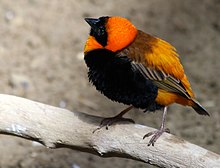Oryx weaver
| Oryx weaver | ||||||||||||
|---|---|---|---|---|---|---|---|---|---|---|---|---|

Oryx weaver ( Euplectes orix orix ), male in courtship dress |
||||||||||||
| Systematics | ||||||||||||
|
||||||||||||
| Scientific name | ||||||||||||
| Euplectes orix | ||||||||||||
| ( Linnaeus , 1758) |
The oryx weaver ( Euplectes orix ) belongs within the family of weaver birds (Ploceidae) to the genus of fire weavers ( Euplectes ).
features
The somewhat squat oryx weavers are 12 to 14 cm tall, the females are slightly smaller. Both sexes look very similar to the house sparrow ( Passer domesticus ) in terms of color . The basic color is ocher brown, on the back they are darkly striped and the belly is shaded light gray. They have a light yellow-brown supercilium. The thick, conical beak is horn-colored. Fledglings have wide, light-colored edges on their wing feathers .
They sing all day long, their call sounds like a "tsip".
Occurrence
The oryx weavers are found in colonies all over South Africa , Botswana , Namibia , Zimbabwe and Mozambique with the exception of northern Namibia, central Botswana and a narrow strip in western Zimbabwe and northern transvaal . However, it only breeds in the Etosha pan . They colonize open terrain and wide grasslands , mostly not far from the water.
nutrition
They feed mainly on grass seeds. Insects also make up part of their diet every now and then.
Reproduction
The male oryx weavers change their plumage during courtship . They then have bright orange to scarlet plumage, while the front head and the belly turn black. The wings and tail, however, remain ocher brown. The beak also turns black. The male's courtship songs are very high-pitched beeps, performed while sitting on high blades of grass, and in between they puff themselves up again and again. They also perform slow hover flights.
The oryx weavers "weave" their round nests in reeds , tall grass, in the bank vegetation, in corn or sugar cane fields . The nests have a side entrance. The female lays around three to five eggs. The male leaves the breeding and brood rearing to the female alone. The young birds hatch after a breeding period of two weeks and leave the nest after another two weeks.
The golden cuckoo is a common brood parasite of the oryx weaver. Oryx weavers remove all eggs that do not resemble the eggs in their clutch. However, some of the females specialize in laying eggs on the oryx weavers and lay eggs that are perfectly matched to the eggs of this host bird. Oryx weavers, however, give up their clutch if they can observe that a female of the golden cuckoo has visited their clutch.
literature
- C. Barlow, T. Wacher, T. Disley: A field guide to birds of the Gambia and Senegal. Pica, Robertsbridge 1997, ISBN 1-873403-32-1 .
- T. Barlow, W. Wisniewski: Southern Africa. Kosmos, Stuttgart 1998, ISBN 3-440-07665-2 .
- J. Delacour: Monograph des veuves. Paris 1934, OCLC 706085053 .
Web links
- Euplectes orix in the Red List of Threatened Species of the IUCN 2008. Posted by: BirdLife International, 2008. Accessed January 31 of 2009.
- Videos, photos and sound recordings for Euplectes orix in the Internet Bird Collection
Individual evidence
- ↑ NB Davies: Cuckoos, Cowbirds and Other Cheats. T & AD Poyser, London 2000, ISBN 0-85661-135-2 , p. 84.

